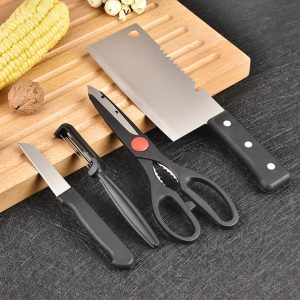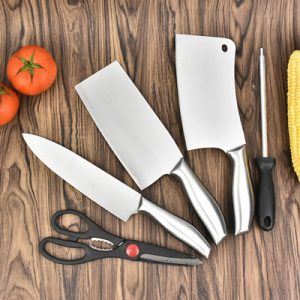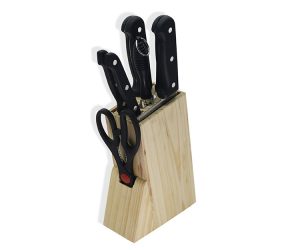Steak knife is a tableware for western food. The steak knife is made of high quality stainless steel. Each stainless steel part of the steak knife is subjected to strict professional quenching heat treatment and sanding polishing. The hardness and gloss are very high, the rust prevention ability is strong, and the hand feel is natural and comfortable. It is especially convenient for western food to eat steak.
The steak knife is more special. Its tip is sharper than the average knife. The knife is bigger, mainly because the steak is more difficult to cut, so the steak knife must be sharper, so that the steak can be cut more easily. High-grade stainless steel and exquisite polishing technology make the steak knife’s noble temperament, thick and full hand, bright and dazzling luster, is absolutely essential equipment in your kitchen cabinet.

Knives and forks hold the law. When using the knife, place the end of the handle in the palm of your hand, with your thumb on the side of the handle, and press your index finger on the handle. Note that the index finger must not touch the back of the knife. The other three fingers are bent. Hold the handle. If the fork is not used with a knife, the fork should be up. Hold the fork as far as possible to hold the end of the fork handle, the fork handle leans on the middle finger, and the middle is supported by the ring finger and the little finger. The fork can be used for fork or feeding alone, or for feeding some head dishes. And pies, you can also use the main dish that does not need to be cut.
The use of cutlery. Hold the knife on the right and hold the fork on the left. First press the food with a fork, then cut it into small pieces with a knife, then use the fork to feed it into the mouth. Europeans do not change hands when using them, that is, holding the fork from the cutting to the food entrance. After the Americans cut, put the knife down and change the right hand fork to feed the entrance.
When the knife and fork are used together, the fork posture is similar to that of holding the knife, but the tines should be downward. Usually the knife and fork are used when feeding the main dish, but if you do not need a knife to cut, you can use the fork to cut, both methods are correct.

The usage of the key. Hold the key with the right hand, hold the fork with the same method, but the finger must be held at the end of the handle. Except for the soup, do not use the spoon to eat other food.
Napkin usage. When eating, the large napkin can be folded up (generally folded in half) and the folds are laid out on the legs. The small napkin can be spread out and spread directly on the legs. Be careful not to hang the napkin on your chest (but in a small space, as on an airplane). Use the upper end of the napkin when wiping the mouth and use the inside to wipe the mouth. Never use it to wipe the face or wipe the knife, fork, etc.
Stainless steel rust removal method
You can use a slightly damp towel to stain the decontamination powder repeatedly. After the rust spots are removed, immediately wipe the surface with clean water, then dry it with a dry cloth or blotting paper. If the embroidered spot on the surface is large, it is recommended to wipe it with a steel ball, but be careful not to enlarge the range. Also, after the rust is removed, immediately wipe the surface with clean water and then dry the surface. Please note that the above cleaning work must be carried out when the weather is relatively dry. And in the future use, wash it with water as much as possible and dry it.

The metal surface is preferentially degreased, and the degreaser is roughly used, and the surface is brushed and rinsed. A rust and rust inhibitor on the market can then be used. At present, there are roughly two types of rust removers which have anti-oxidation functions and no anti-oxidation functions. It is recommended to use the former, because stainless steel railings are not necessarily coated with anti-oxidation paint. In order to avoid secondary rust, the use of rust and rust inhibitors can generally safely remove rust, and can prevent secondary rust of railings for a period of time.
